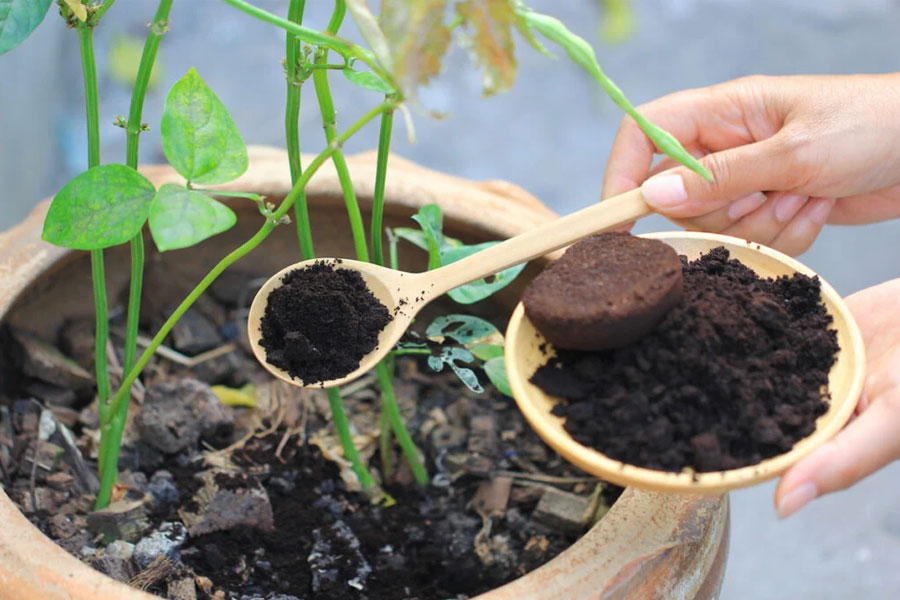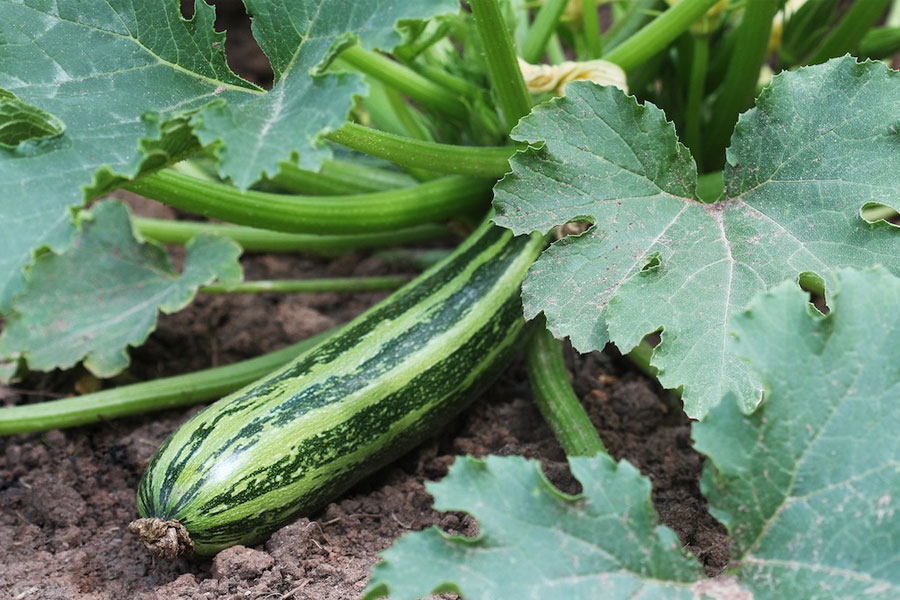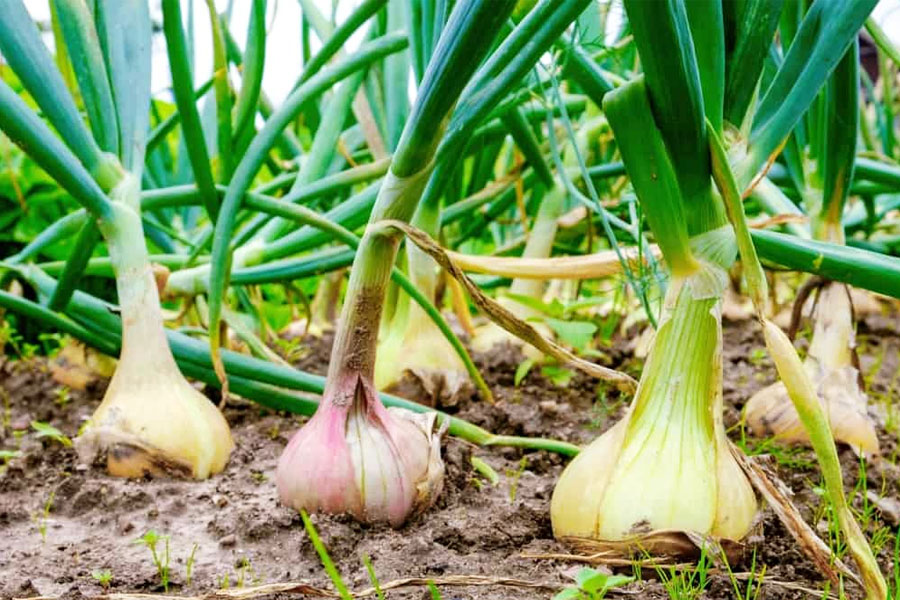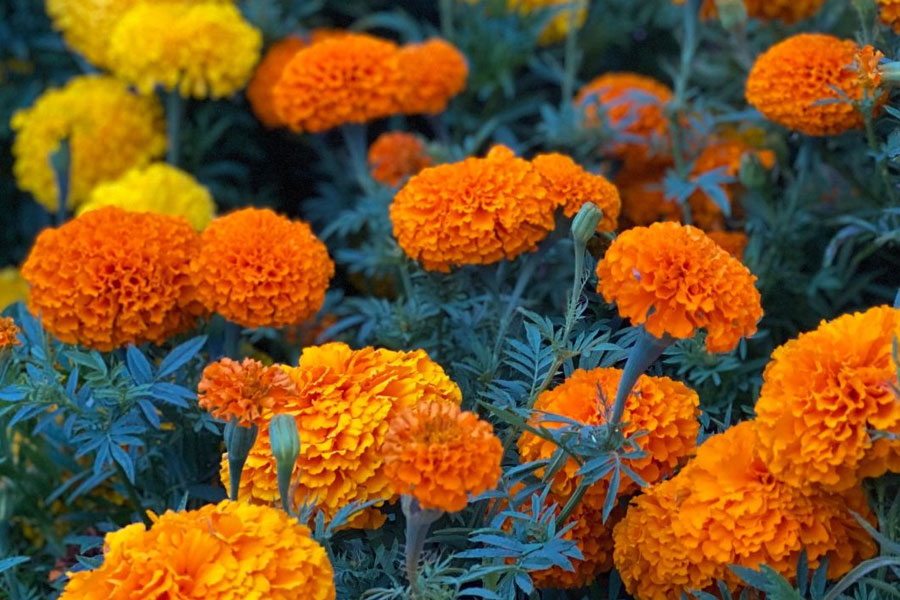
Want to take your tomato harvest from boring to hero? Surround them with superstar companions! The right plant pairings can boost your tomato yield, deter pesky insects, and even improve the flavor. Ready to unlock the secrets of a thriving tomato jungle? Dive into our list of the 20 best tomato companion plants and watch your tomato dreams become reality!
20 Companion Plants for Tomatoes

1. Basil

Basil is one of the most popular companions for tomatoes. It is believed to enhance the flavor of tomatoes and repel harmful insects such as aphids, spider mites, and whiteflies. The aromatic oils in basil act as a natural insect repellent, providing a protective barrier for tomato plants. Additionally, basil attracts beneficial insects like bees, which are essential for pollination.
2. Marigolds

Marigolds are known for their pest-repellent properties. They produce a substance called alpha-terthienyl, which helps to deter nematodes that can damage tomato roots. Marigolds also attract beneficial insects such as ladybugs and hoverflies, which prey on common tomato pests like aphids and whiteflies.
3. Garlic

Garlic is a strong-smelling plant that can repel a variety of pests, including spider mites and aphids. When planted near tomatoes, garlic can help to protect them from these harmful insects. Garlic also has antifungal properties, which can reduce the risk of fungal diseases in tomato plants.
4. Chives

Chives are a member of the allium family and have similar pest-repellent properties to garlic. They can help to deter aphids and other small insects that can harm tomato plants. Chives also improve the overall health of the soil, making it more fertile and conducive to healthy tomato growth.
5. Parsley

Parsley is another beneficial companion for tomatoes. It attracts beneficial insects like hoverflies and parasitic wasps, which prey on tomato pests. Parsley also helps to improve the overall health of the soil by adding essential nutrients and organic matter.
6. Carrots

Carrots are a good companion for tomatoes because they help to aerate the soil, improving its structure and drainage. This is beneficial for tomato roots, which need well-drained soil to thrive. Carrots and tomatoes also have different nutrient requirements, so they do not compete for the same resources.
7. Onions

Onions are effective at repelling a variety of pests, including aphids, spider mites, and carrot flies. When planted near tomatoes, onions can help to protect them from these harmful insects. Onions also have shallow roots, so they do not compete with tomatoes for water and nutrients.
8. Lettuce

Lettuce is a fast-growing plant that can be used as a living mulch for tomatoes. It helps to suppress weeds and keep the soil moist, reducing the need for frequent watering. Lettuce also provides ground cover, which can protect tomato roots from extreme temperatures.
9. Spinach

Spinach is another excellent companion plant for tomatoes. It grows quickly and provides ground cover, helping to suppress weeds and retain soil moisture. Spinach also improves soil structure and fertility, making it more conducive to healthy tomato growth.
10. Cilantro

Cilantro attracts beneficial insects like ladybugs and parasitic wasps, which prey on common tomato pests. It also has a strong aroma that can help to mask the scent of tomatoes, making them less attractive to harmful insects. Cilantro can also improve the overall health of the soil by adding organic matter.
11. Borage

Borage is a flowering herb that attracts pollinators such as bees, which are essential for tomato pollination. It also helps to repel tomato hornworms, a common pest that can damage tomato plants. Borage improves soil health by adding trace minerals and organic matter.
12. Nasturtiums

Nasturtiums are excellent companion plants for tomatoes because they act as a trap crop for aphids, drawing them away from the tomato plants. They also attract beneficial insects like predatory beetles and hoverflies, which help to control other tomato pests. Nasturtiums improve soil health by adding organic matter and nutrients.
13. Cucumbers

Cucumbers and tomatoes have similar growing requirements and can be planted together. Cucumbers can provide ground cover, helping to suppress weeds and retain soil moisture. Both plants benefit from the increased pollination provided by each other’s flowers, leading to higher yields.
14. Asparagus

Asparagus and tomatoes make good companions because they have different growing seasons and nutrient requirements. Asparagus roots grow deep into the soil, while tomato roots are more shallow. This allows them to coexist without competing for resources. Asparagus can also help to repel nematodes that can harm tomato roots.
15. Beans

Beans are nitrogen-fixing plants that can improve soil fertility by adding nitrogen, an essential nutrient for tomato growth. They also provide ground cover, helping to suppress weeds and retain soil moisture. Beans and tomatoes can benefit from each other’s presence, leading to healthier and more productive plants.
16. Peppers

Peppers and tomatoes are both members of the nightshade family and have similar growing requirements. They can be planted together to maximize space and resources. Peppers can help to repel certain pests that affect tomatoes, and their close proximity can improve overall pollination and yield.
17. Mint

Mint has a strong aroma that can help to repel pests like aphids, spider mites, and ants. When planted near tomatoes, mint can provide a protective barrier against these harmful insects. Mint also attracts beneficial insects like predatory wasps, which can help to control tomato pests.
18. Oregano

Oregano is a fragrant herb that can help to repel pests such as aphids and spider mites. It also attracts beneficial insects like bees and butterflies, which are essential for pollination. Oregano can improve the overall health of the soil by adding organic matter and nutrients.
19. Thyme

Thyme is another aromatic herb that can help to repel pests like aphids and whiteflies. It attracts beneficial insects like bees and parasitic wasps, which can help to control tomato pests. Thyme also improves soil health by adding organic matter and nutrients.
20. Radishes

Radishes are fast-growing plants that can be used as a trap crop for pests like flea beetles, drawing them away from tomato plants. They also help to aerate the soil, improving its structure and drainage. Radishes and tomatoes have different nutrient requirements, so they do not compete for the same resources.
By incorporating these companion plants into your tomato garden, you can create a more resilient and productive growing environment. Each companion plant offers unique benefits, from pest control to soil improvement, making them valuable allies in the quest for healthy and bountiful tomato harvests.
Frequently Asked Questions
1. What is companion planting?
Companion planting is the practice of growing different plants close together to benefit each other by enhancing growth, repelling pests, and improving soil health.
2. How does companion planting improve pest control?
Certain plants produce natural chemicals or scents that repel harmful insects, reducing the need for chemical pesticides.
3. Can companion planting improve soil health?
Yes, some companion plants improve soil structure and fertility by adding organic matter and nutrients or by fixing nitrogen in the soil.
4. What are some good companion plants for tomatoes?
Basil, marigolds, garlic, chives, and parsley are excellent companion plants for tomatoes, providing benefits like pest control and improved growth.
5. Does companion planting affect the flavor of tomatoes?
Yes, some companion plants like basil can enhance the flavor of tomatoes, making them taste better.













